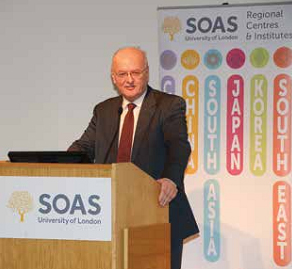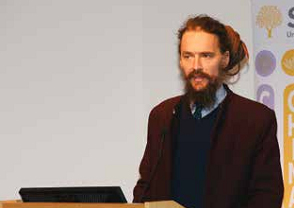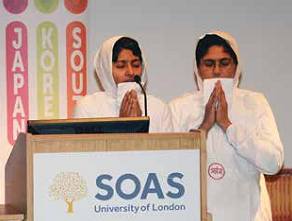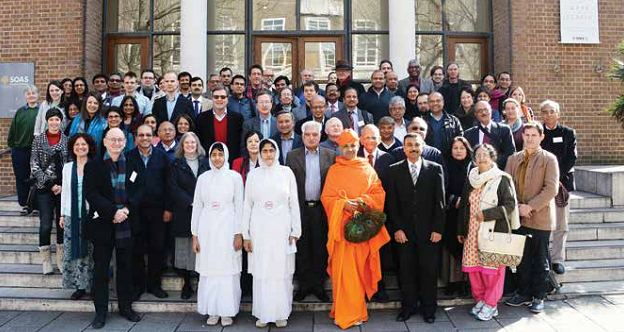
Centre of Jaina Studies Newsletter: SOAS - University of London
On Thursday evening, 19 March 2015, in the Brunei Gallery Lecture Theatre at SOAS, a renowned expert in the field of Śaivism and Tantra, Professor Alexis Sanderson (University of Oxford) introduced the topic of the 17th Annual Jaina Studies Workshop, Jaina Tantra, to a large audience of scholars and practitioners of Jainism. Sanderson was introduced on this occasion by his former student, yoga specialist Sir James Mallinson (SOAS).
In the 15th Annual Jaina Lecture: The Jaina Appropriation and Adaptation of Śaiva Ritual: The Case of Pādliptasūri's Nirvāṇakalikā, Sanderson gave an account of how Śaivism and Śaiva Tantra influenced other South Asian traditions. Vaiṣṇava, Buddhist, and Jaina authors incorporated the tantric methods devised by the Śaivas into their own texts, and indeed often used Śaiva ritual manuals as the basis for their own works. Although these methods and texts were to a varying degree adapted to suit the tradition to which they were translated, traces of this process of translation are still detectable in the texts. It is precisely these traces that Sanderson looked for in his reading of the 11th to 12th-century ritual manual Nirvāṇakalikā by the author Pādaliptasūri. In this text, tantric procedures for daily worship, initiation, consecration, ceremonies for installation of idols, etc., are described in detail. Sanderson proceeded by pointing out that the Nirvāṇakalikā closely resembles an unpublished Śaiva tantric manual, the Siddhāntasārapaddhati of Mahārājādirāja Bhojadeva (11th century), which is preserved as a palm leaf manuscript in the Kathmandu valley. In fact, the Nirvāṇakalikā seems to be a creative redaction of the Siddhāntasārapaddhati, with some strategic deletions and adaptations to fit the original Śaiva tantric material into its new Jaina context. Such adaptations include superficial redactions ('Śiva' becoming 'Jina') and more elaborate changes (deletions or reinterpretations of the bloodiest rituals, adaptation to a new pantheon, etc.). Although the Nirvāṇakalikā includes some original passages, Sanderson demonstrated that there is sufficient proof that the Śaiva text functioned as its 'matrix'.

Alexis Sanderson (University of Oxford)

Sir James Mallinson
This comparison of these two tantric manuals illustrates the larger processes of Jaina appropriation and adaptation of Śaiva tantric rituals. Sanderson pointed out that this appropriation should not surprise us. As Śaiva Tantra was a very influential current from the 9th century until about the 14th century, it is only natural that other traditions borrowed elements in this case methods from it. On the other hand, the relationship of Jainism with Tantra is at best an ambivalent one. Not only does the idea of using 'magical' means to bypass the natural cycle of rebirth and the shedding of karma clash with the commonly held idea of individual responsibility on the path towards mokṣa, the more sexual and violent aims of some of the tantric rituals and formulas are also at odds with Jainism's ethics of ahiṃsā (non-violence) and brahmacarya (chastity). Picking up on these tensions and ambivalences, the impromptu discussion that followed the opening lecture centred on the question whether tantra could ever truly be integrated in the tradition of Jainism, and on the representativeness of the text under scrutiny.
Sanderson's lecture provided participants and the audience with food for thought. Indeed, many of the questions and points of contention that were touched upon in the opening lecture were reiterated in the papers and presentations at the Jaina Workshop on Friday. The papers presented at the workshop were grouped into four sessions: textual studies, tantric elements in Jaina systems of meditation, tantra in Jaina rituals, and the relationship between Hindu Tantra and tantric elements in Jainism. Paul Dundas (University of Edinburgh) kicked off the first session, and started the day with a reference to John Cort's (1987) work on medieval Jaina goddess traditions, in which he suggests that tantra never became a central religious idiom in Jainism, owing to the fact that it could not entertain the possibility of a 'leap soteriology' as opposed to the step by step path to mokṣa.
Building on this observation, Dundas affirmed that the incorporation of tantric methods into Jainism was limited in scope, and has throughout history been a source of scholarly ambivalence and discussion. Tantra in Jainism thus does not involve alternative initiations, and no text overtly claims to include rituals effecting an accelerated ascension to the state of Jina. Dundas continued, focussing on Somasena Bhaṭṭāraka's account of the quotidian Jaina ritual praxis to illustrate the historic and scholarly ambivalence towards the 'six magical actions' (ṣaṭkarmāṇiṇ) in general, and rituals aimed at doing harm (such as māraṇaṇ or killing) in particular. Indeed, in Somasena Bhaṭṭāraka's work the term 'māraṇa' is often substituted with the term 'niṣedha' or prohibition (to indicate that these actions are ethically unsound) or 'mohana' or delusion (to indicate the real aim of the ritual is the burning away of karma and illusion).
To further illustrate this phenomenon, Dundas looked at other Digambara and Śvetāmbara texts that discuss the ṣaṭkarmāṇi. He identified two types of response of Jaina authors to the tantric materials they encounter: tantric elements are either reinterpreted along doctrinal or spiritual lines, or strategically censured by editors. Dundas emphasized that his aim was not to shed light on some 'darker side' of Jainism, but rather to recognize the presence of tantric elements in Jaina literature, and attempt to study them in an unbiased way. He concluded that although elements of tantra are present in Jainism and Jaina texts, this does not amount to a full 'Jaina Tantrism', as the tensions between parts of the Indic tantric system and the soteriology and doctrine of the Jaina tradition prevented the full appropriation of tantra as a way to spiritual enlightenment.
Jagat Ram Bhattacharyya (Shantiniketan, India) presented his ongoing efforts to edit the tenth text of the Śvetāmbara canon, the Praśnavyākaraṇa. The original text of the Praśnavyākaraṇa was long deemed lost. However, Bhattacharyya has accessed a manuscript from archives in Nepal in Śaurasenī Prakrit with Sanskrit and Prakrit commentary.[1] This difficult, somewhat esoteric text illustrates how the Jaina textual tradition is composed of works dealing with very different, sometimes seemingly contradictory topics in response to different questions that arise in different contexts, at different times and in reaction to other traditions. The text was said to have been hidden away to prevent misuse of its supernatural content by unsuitable students. The Praśnavyākaraṇa itself makes use of the anubandha catuṣṭaya (fourfold connection) to describe the way in which, and by whom, it is to be studied and used to gain knowledge. The literal translation of Praśnavyākaraṇa is: 'the question of grammar'. However, this does not cover the actual contents of the work, and the alternative meanings of 'praśna' are subject of much discussion in the available commentary texts. Indeed, after the preliminary discussion of who is an appropriate student, and what the subject matter actually is, the Praśnavyākaraṇa first appears to be a study of elements of Pāṇninian grammar and sounds. In later chapters the text reveals its tantric content more clearly, dealing with nimitta-śāstra (the study of omens) and further describing how different sounds and seed-mantras (bīja-mantra) are associated with living beings, metals, colours and numbers.
In the last paper of the panel on textual studies, Ellen Gough (Yale University) talked about the history and present day use of one specific tantric element, namely the ritual invocation called the 'sūri-mantra'. In a Śvetāmbara context, this mantra is used in the ordination of the heads of mendicant orders (ācāryapada-sthāpanā) and in image consecration (pratiṣṭhā) ceremonies. Today, Digambaras denote different incantations as 'sūrimantra', but all of these have only one ritual function: the consecration of temple icons. Medieval texts suggest, however, that Digambaras, like Śvetāmbaras, once used the sūri-mantra to promote monks to the highest rank of the ascetic order, and that they may even have used the same invocation as Śvetāmbaras. Gough argued that remnants of this can be seen in modern Digambara imageconsecration ceremonies, where according to some sources a Jaina layman performing the ceremony must remove all of his clothes before he whispers the sūrimantra into the ear of the Jina icon (mūrti). According to Gough, the lay worshipper thus temporarily assumes the guise of a Digambara monk, a clear reference to the older practice where only naked ācāryas could perform pratiṣṭhā rites using the sūri-mantra, imparted to them upon their promotions as part of the ācāryapadasthāpanā ceremony.
The second session of the workshop dealt with Jaina meditation and its tantric elements. Shugan Chand Jain (International Summer School for Jain Studies, New Delhi) explored the text by the Digambara monk Śubhacandra (10th or 11th century CE) to delimit the place of meditation in the Jaina tradition. Śubhacandra devoted a substantial part of this work to ascetic practice and conduct, which includes meditation as a tool. Generally, meditation implies the restraint of the wondering nature of mind, body and soul, to enable one to concentrate. The principle aim is the attainment of mokṣa, but the manifestation of consciousness in itself (śuddha upayoga) is also an aim, such as in the kali yuga where this is the highest level that one can reach. Although Śubhacandra discussed meditation from the perspective of both mendicants and the lay community, his emphasis is clearly on the mendicant. The aspiring practitioner is required to become a yogī, develop equanimity, and practice austerities as necessary precursors to true meditation. Śubhacandra further described two methods of meditation: step-by-step and continuous, which he argued is preferable. Additionally, he saw a bifurcation of types of meditation as unworthy and worthy meditation, the latter of which again comprises two types: dharmadhyāna (meritorious meditation) and śukla-dhyāna (pure meditation). Here Śubhacandra used the term savīryata-dhyāna (heroic meditation) for the practice of using the energy of the soul to purify itself. Jain concluded his presentation by pointing out the influence of Śubhacandra's work on later Jaina authors writing about meditation and yoga, such as Hemacandra, and related how the Jñānārṇava still forms the basis of many contemporary Jaina meditation practices.
Christopher Key Chapple (Loyola Marymount University, Los Angeles) began his paper with a reference to the same Jñānārṇava by Śubhacandra. He indicated that his intention was to make explicit the connection to tantra by returning to the question of the soteriological leap mentioned by Paul Dundas earlier. The term 'yoga' is not used without prefixes in the earliest Jaina canonical texts. 'Yoga' was seen as something negative, meaning the binding of karmas, so the prefixes a- or vi- are added to describe the shedding of it. From the 6th century CE onwards, a shift in meaning occurred. 'Yoga', now meaning anything related to spirituality, became gradually more accepted. By the 10th and 11th centuries, when Śubhacandra and his successor Hemacandra were writing, the tantric 'layer' of yoga (comprised of tools and methods like yantra, mantra, maṇḍala, etc.) had become an integral part of it. In visualizing a sequence of elements (pāñca mahābhūta) with their respective syllables, colours and geometric forms in which the flame of tapas is the last and most important step, the yogī gradually comes to see the supreme self, which can be said to be a form of (temporary) enlightenment. Chapple concluded that on the face of it, Jaina texts on yoga such as the Jñānārṇava do seem to exhibit some form of the conception of soteriological leap. However, the burning flame of tapas continues to be central in all these meditations, and the glimpses of the pure self and omniscience are temporary. In this sense, it is not so much a soteriological leap as an appropriation and reinterpretation of the popular technologies of tantra into the Jaina tradition.
Samaṇī Pratibhāprajñā (SOAS & Jain Viśva Bhāratī Institute, Ladnun) closed this panel with a talk centred on a more recent exponent of Jaina meditation. She presented her work on the integration of tantric elements in the prekṣā-meditation system worked out by Ācārya Mahāprajña (1920-2010). In this system tantric tools from the Hindu and Buddhist traditions are transformed into Jaina practices consistent with doctrine. She concluded that Ācārya Mahāprajña must have studied different tantric manuals, as he synthesized these techniques to fit into Jainism and be consistent with modern science (especially neuro-endocrinology). The concept of kuṇḍalinī is a fruitful example of this mechanism. In traditional tantric yoga, the life force kuṇḍṇalinī can be activated by certain practices to rise from the bottom of the spinal cord to the top of the head, thus breaking through the main cakras. Within the Jaina framework, we find no reference to kuṇḍalinī as such. However, Ācārya Mahāprajña claimed that the idea of kuṇḍalinī is an ancient one, similar to 'tejo leśyā' and the power of consciousness activated by the 'tejas body'. Samaṇī Pratibhāprajñā illustrated how we find different perspectives on this concept of kuṇḍalinī throughout

Samaṇī Pratibhāprajñā (SOAS & Jain Viśva Bhāratī Institute, Ladnun) and Samaṇī Praṇavaprajñā (Jain Vishva Bharati Institute, Ladnun)
Jaina literature. Descriptions of visualizations, mantras, granthis (similar to cakras) become progressively more prevalent as we move closer to present time. In the prekṣā-meditation system, this idea of kuṇḍalinī is captured in the concept of antaryātrā (internal journey), the second limb of the eightfold meditation system. This internal journey is meant to direct the flow of vital energy upwards, as is needed to activate the deeper level of consciousness. Although he used tantric terms such as cakra and kuṇḍalinī, Samaṇī Pratibhāprajñā pointed out how Ācārya Mahāprajña interpreted these concepts in a modern scientific way, associating them with the central nervous system.
The first paper of the third session of the workshop, dealing with tantric elements in Jaina ritual, was presented by Michael Slouber (Western Washington University). Slouber's presentation provided a broad overview of the medieval Indic tradition of tantra. He reiterated how it came to be embedded in different traditions over time. Although there seems to be an absolute rift between the Jaina emphasis on nonviolence and chastity on the one hand, and the correlations of tantra with black magic and sexuality on the other, Jainism is no exception here. In the medieval period Jaina authors compiled their own mantra-śāstra traditions. Although some adaptation of the original material to the Jaina doctrine took place, these mantra-śāstras still contain (traces of) explicitly sexual or violent content or aim. Drawing from Jaina 'tantras' such as the Jvālāmālinīkalpa and its descendent, the Bhairavapadmāvatīkalpa, Slouber confirmed that SouthAsian tantra traditions and Jainism are more complexly and intensely interconnected than is often assumed.
Peter Flügel (SOAS) turned our attention from mantra-śāstra texts to divination rituals performed in Digambara Jaina shrines in South India. Pilgrims come to these shrines to perform rituals to yakṣiṇīs, in the hope of getting a glimpse of the future. Jaina yakṣas and yakṣiṇīs, male and female demons or demi-gods, are classified in the Jaina scriptures as the fifth of the eight classes of vyantara or vāṇamantara gods, and convey their brahmanic origin through their names and symbols.
In Jainism, they are first and foremost appropriated as devotees associated with a particular tīrthaṅkara. Three yakṣiṇīs have become particularly popular: Aṁbikā (attending goddess to Neminātha), Padmāvatī, (attending goddess to Pārśvanātha), and Jvālāmālinī (attending goddess to Candraprabha). Whereas most of the yakṣas and yakṣiṇīs have become mere accessories to the tīrthaṅkara they are associated with, these three have become protective deities that are worshipped in their own right. During his fieldwork in Karnataka, Flügel visited several trans-regional pilgrimage sites such as Hombuja, Mūḍabidarī and Narasiṃharājapura, famous for their flower oracles, whose variations in ritual practice, explanations of ritual efficacy and practitioners he studied. The divination rituals of the flower oracle are closely related to practices found in nearby Hindu shrines. The devotees' aims are usually directed towards the attainment of worldly things: success, health, love, etc. Although they have little to do with Jaina spirituality or doctrine, these tantric rituals are quite popular and have become a significant aspect of Jaina ritual practice.
The fourth and last session of the workshop delved deeper into the relationship between tantra in Jainism and Hindu tantric practices. In his paper on the receptions of the Nāths and Haṭṭhayogīs in Pre-Colonial North India, John E. Cort (Denison University) described the views of Banārasīdās (1586-1643) and Ṭoḍarmal (1719-1766) on two different Hindu yoga traditions. In the Banārsī Vilās, the 'collected works' of Banārsīdās, a volume on the teachings of Gorakhnāth (Gorakhnāth ke Vacan) is included. Although this text was probably not authored by Banārasī himself, the booklet illustrates his positive reception of the Nāth tradition. A century later, Pandit Ṭoḍarmal writes about Hindu yoga traditions in his Mokṣamārgaprakāśaka. Ṭoḍarmal seems to be quite knowledgeable on Haṭha Yoga especially, but he is unimpressed by the practices of the yogīs he describes. To him, these practices of 'breath control' are more akin to acrobatic tricks than to actual spiritual advancement. An examination of these two works not only illustrates the ambivalent relationship between Jainism and Hindu yogic and tantric methods, but also makes clear that motivations for writing play an important part and should be taken into account. Whereas Banārasīdās was for most of his life a spiritual seeker, who found the Nāth tradition to be compatible with Digambara Adhyātma, Ṭoḍarmal writes as an ideologue of the Terāpanth, dismissing yoga, along with many other traditions, as a set of tricks and delusions.
Olle Qvarnström (University of Lund) presented an analysis of a selection of Jaina paintings located in the Indra Sabhā cave complex at Ellora. In his search for tantric features, Qvarnström looked at artwork portraying celestial beings (gandharvas, apsaras or vidyādharas), mortal couples, gaṇas, an eight-armed dancing Indra, and Bāhubali and Bharata (duelling armed with foils and shields) a picture probably inspired by Jinasena's 9thcentury Ādipurāṇa. However, Qvarnström concluded that in spite of his initial presumptions, none of these pictorial elements can be regarded as specifically tantric or labelled as 'tantra'. Based on the paintings Qvarnström researched, there is very little visible tantric influence in Jaina art at Ellora.
Roudtable
For the first time, the Jaina Studies Workshop ended with a Roundtable. The question put forth for discussion was: 'In the 19th century, many Indian social and religious reformers differentiated "custom and rituals" from "true religion". Is this distinction still relevant for lived Jainism today?' John E. Cort (Denison University) chaired the roundtable and opened the discussion by stressing the historical developments underlying the distinction between custom and rituals and 'true religion', namely the protestant-inspired colonial beginnings of the study of Asian traditions, and the processes of modernity that have had to be confronted since. An elaborate panel of Jains from different fields and careers, including Bhaṭṭāraka Cārukīrti (Jain Maṭha Jain Kāśi Mūḍabidarī), responded to this question, before the floor was opened to questions from the audience.

Atul Shah (University Campus Suffolk) placed some preliminary question marks, wondering about the sense and nonsense of holding on to the customs/ rituals versus true religious bifurcation. He argued that a strict separation of the two has never been relevant for Jainism, or for Indian traditions in general, and can be seen as a concept of colonial invention designed to order, categorize, and perhaps divide the South-Asian population. Taking Shah's caveats into consideration, the discussion then focussed on the place of ritual and tantra in Jainism, and their relationship with Jainism's core ethical ideals. Ashok Jain (Department of Physics, Indian Institute of Technology, Roorkee) felt that rituals have become more prevalent in Jainism over recent years. Comparing how Jainism used to be practiced in his family with the current situation, he argued that the elaborate rituals that are preformed nowadays are not in keeping with the tenets of Jainism. He did concede that some rituals are perhaps needed to keep the laypeople rooted, but warned that these should be kept to a minimum. Since the next generations are looking for logical explanations, a reinterpretation of the basic tenets of the Jaina tradition to fit into a 21st-century context would be a better way to keep Jainism alive. But have rituals become more important over the last decades? In her presentation Bindi Shah (University of Southampton) pointed out that her research on young Jains in the UK does not confirm that rituals are progressively becoming more important. Indeed, she sees many young Jains studying Jaina texts and thinking about the applications of Jaina dharma in a context of conflicting value systems, in a bid to develop a committed Jaina practice. Samani Pratibha Pragya (SOAS, Jain Vishva Bharati Institute, Ladnun) agreed, saying that true religion should be treasured, but also re-examined as time progresses. She pointed to the ancient bifurcation of mūla-guṇa and uttara-guṇa: between elementary and supplementary virtues/rules as a possible alternate approach to rituals and customs versus the religious divide as discussed by the panel.
Following up on the idea that some rituals are perhaps necessary for at least part of the lay community, Shamlal Godawat (Maharana Pratap University of Agriculture & Technology, Udaipur), Chakresh Jain (Jaypee Institute of Information Technology, New Delhi) and Ashok Jain (Gwalior University) brought the topic of the workshop, Jaina Tantra back into the discussion. Their consensus was that the introduction of tantric elements into Jainism was merely a change of method. According to them, the introduction of more elaborate rituals, mantras, deities, etc. is a personal choice of the individual devotee. They argued that the addition of such elements does not harm or diminish the central core of the Jaina tradition, and is perhaps inevitable in our current time. The idea that elaborate rituals and a reliance on tantra are phenomena typical for the kali yuga was introduced by a member of the audience. But what is true religion in the case of Jainism? For many of the panellists, like Sanjeev Sogani (Gyan Sagar Science Foundation, New Delhi), the central core of the Jaina tradition is its system of ethics or the Jaina way of life. He compared the situation of Jainism with that of a gold coin. Such a coin can get dirty, and be covered in dust, but without losing any of its intrinsic value. In the same way, the use of tantric elements and rituals in Jaina practice does not lessen the value of the true religion. Kalyan Gangawal (Gyan Sagar Science Foundation, Pune) agreed that Jaina ethics are at the core of what was described as 'true religion', and suggested how the wide adoption of a Jaina or Jainavegetarian lifestyle can prevent further global warming. He illustrated this argument by referring to western authors and politicians that do to a certain extent follow such a lifestyle.

During the discussion following the panellists' introductions and thoughts, members from the audience had the chance to comment and ask additional questions. Again, many remarks came back to the question of the difference between custom and rituals on the one hand, and true religion on the other. At what point do custom and ritual become true religion, and how do we differentiate? In conclusion, John Cort offered that perhaps, the distinction between kriyā and dhyāna, and the balance between them would be a fruitful way to look at this topic. Certainly, the last word has not been said in this discussion. After thanking our host Peter Flügel and the entire SOAS team, as well as the sponsors, the SOAS Jaina Workshop 2015 was officially closed.
Tine Vekemans is currently pursuing a PhD in Indian Languages and Cultures at Ghent University in Belgium. Her research focusses on contemporary Jainism, the Jaina diaspora, and Jainism's involvement with ICT and new media.
 Dr. Tine Vekemans
Dr. Tine Vekemans